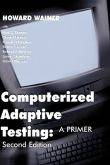Computerized Adaptive Testing a Prime 2 ed.<
Wainer, H \ Dorans N.J. al.
Éditeur : LAWRENCE ERLBAUM ASSOCIATES
ISBN papier: 805835113
Parution : 2000
Code produit : 1180924
Catégorisation :
Livres /
Génie /
Informatique /
Programmation
Formats disponibles
| Format | Qté. disp. | Prix* | Commander |
|---|---|---|---|
| Livre papier | En rupture de stock** |
Prix membre : 104,45 $ Prix non-membre : 109,95 $ |
*Les prix sont en dollars canadien. Taxes et frais de livraison en sus.
**Ce produits est en rupture de stock mais sera expédié dès qu'ils sera disponible.
Description
This celebrated primer presents an introduction to all of the key ingredients in understanding computerized adaptive testing technology, test development, statistics, and mental test theory. Based on years of research, this accessible book educates the novice and serves as a compendium of state-of-the-art information for professionals interested in computerized testing in the areas of education, psychology, and other related social sciences. A hypothetical test taken as a prelude to employment is used as a common example throughout to highlight this book's most important features and problems. Changes in the new edition include: *a completely rewritten chapter 2 on the system considerations needed for modern computerized adaptive testing; *a revised chapter 4 to include the latest in methodology surrounding online calibration and in the modeling of testlets; and *a new chapter 10 with helpful information on how test items are really selected, usage patterns, how usage patterns influence the number of new items required, and tools for managing item pools.























